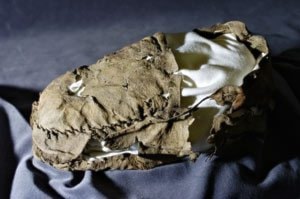When Cody Joe found a piece of animal skin while researching a southern Yukon ice patch he wasn’t sure what it was.
Neither was Yukon conservator Valery Monahan.
It arrived in the territory’s archeology lab on Industrial Drive in August 2003 in rough shape. It was little more than a balled-up, broken piece of frozen hide covered in thick moss and caribou dung.
“We thought it was a bag or pouch of some kind,” said Monahan.
Over the next year she put more than 240 hours of painstakingly intricate work into cleaning and reshaping the artifact.
She took photographs, made drawings and removed a small piece for radiocarbon dating.
Little by little, the misshapen piece of history revealed its secrets.
After carefully reconstructing the pieces Monahan found the mysterious artifact was a moccasin made of animal hide sewn together with sinew.
It’s the only sewn-hide object that’s been found in the ice patches.
And the carbon dating found it to be about 1,400 years old making it the oldest-known moccasin found in Canada.
“It’s the first of its kind,” said Monahan. “We don’t have any other examples of footwear that date from that time … most of the examples we know of are no more than 100 years old.
“In Canada there are very few examples of First Nations clothing that’s any age because so much of it just didn’t survive archeologically.”
When Monahan wasn’t working on the moccasin it was kept frozen so it wouldn’t deteriorate.
She did all the work under a microscope to avoid damaging the delicate object.
“It had a fair bit of moss that was growing on it and through it, basically I had to hold each piece of moss with tweezers and then cut the base of the moss with a scalpel as close to the moccasin as possible.”
The hide is likely to be caribou, but it’s hard to be sure, said Monahan.
When the hide was processed the identifying details were lost — the hair was scraped off and the characteristic patterns that distinguish one animal’s skin from another disappeared.
It’s impossible to tell whether the footwear belonged to a man, woman or child, said Monahan.
It’s about 24 centimetres long, about a men’s size five, said Monahan.
“Whoever wore it was quite small, but because of the association with the ice patches it’s pretty clear that it likely belonged to a hunter. All of the activity that’s associated with these archaeological sites is all hunting activities.”
“Yet another exciting find,” said Yukon Culture minister Elaine Taylor. “It’s absolutely wonderful to see that it was a young person from the Champagne/Aishihik First Nations who discovered the moccasin, not to mention other finds.
“It certainly speaks to the Yukon’s rich First Nations history,” said Taylor. “We continue to pursue our partnerships with First Nations in the Yukon to continue these discoveries, of course it’s an educational experience for all of us.”
Currently the object rests on a three-dimensional mount in the territory’s offices.
The next step is to analyze the red pigment found on some areas of the hide, said Monahan. The piece is available to researchers, but currently there are no plans for a public exhibition.
The ice patch exploration began in 1997, when Yukon governments realized the alpine ice was melting and uncovering archeological objects. Objects uncovered so far have been dated between 100 years to 8,200 years old.
The research is partnership between Yukon Tourism and Culture and Environment departments, and six First Nations: Carcross/Tagish First Nations, Champagne/Aishihik First Nations, Kluane First Nation, Kwanlin Dun First Nation, Ta’an Kwach’an Council and Teslin Tlingit Council.
The patches are located throughout the Southwest Yukon.
